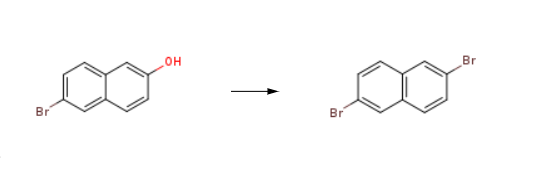| Identification | More | [Name]
2,6-DIBROMONAPHTHALENE | [CAS]
13720-06-4 | [Synonyms]
2,6-DIBROMONAPHTHALENE
2,6-DIBROMONAPHTHALENE, 98.5%
2,6-Dibromonapthalene | [EINECS(EC#)]
803-009-5 | [Molecular Formula]
C10H6Br2 | [MDL Number]
MFCD01026462 | [Molecular Weight]
285.96 | [MOL File]
13720-06-4.mol |
| Chemical Properties | Back Directory | [Melting point ]
163-166°C | [Boiling point ]
339.1±15.0 °C(Predicted) | [density ]
1.834±0.06 g/cm3(Predicted) | [storage temp. ]
Sealed in dry,Room Temperature | [form ]
powder to crystal | [color ]
White to Gray to Brown | [Water Solubility ]
Insoluble in water. | [InChI]
InChI=1S/C10H6Br2/c11-9-3-1-7-5-10(12)4-2-8(7)6-9/h1-6H | [InChIKey]
PJZDEYKZSZWFPX-UHFFFAOYSA-N | [SMILES]
C1=C2C(C=C(Br)C=C2)=CC=C1Br | [CAS DataBase Reference]
13720-06-4(CAS DataBase Reference) |
| Safety Data | Back Directory | [Hazard Codes ]
Xi,N | [Risk Statements ]
37/38-41-51/53 | [Safety Statements ]
S22:Do not breathe dust .
S24/25:Avoid contact with skin and eyes . | [RIDADR ]
UN 3077 9 / PGIII | [WGK Germany ]
3 | [HS Code ]
29039990 |
| Hazard Information | Back Directory | [Description]
2,6-Dibromonaphthalene is an important material intermediate compound used as building blocks to construct small semiconductor molecules or polymers in organic photovoltaic, OLED and OFET devices. | [Chemical Properties]
Light yellow solid | [Uses]
2,6-Dibromonaphthalene is an important raw material and intermediate used in organic synthesis, pharmaceuticals and agrochemicals. It reacts with hexylmagnesium bromide to form 2,6-Dihexyl-naphthalene. | [Synthesis]
2,6-Dibromonaphthalene is synthesised using 6-Bromo-2-naphthol as a raw material by chemical reaction. The specific synthesis steps are as follows:
Bromine (78.8 g, 493 mmol) was added dropwise to a cooled (0 °C) solution of triphenylphosphine (129 g, 493 mmol) in anhydrous CH3CN (200 mL) and the solution was stirred for 30 min at rt. A solution of 6-bromo-2-naphthol (100 g, 448 mmol) in anhydrous acetonitrile (CH3CN) (200 mL) was added, and the reaction mixture was stirred for a further 2 h at 70 °C. After removal of the solvent (bath temp was increased to 140 °C), the residue was heated to 300 °C for 1 h. After being cooled to 100 °C, the black tar was dissolved in toluene (100 mL), and cooled to rt while stirring. The resulting solution was washed with 1 N NaOH and water, followed by drying over MgSO4. The solvent was removed in vacuo and the residue was dissolved in MeOH (50 mL). The precipitate was filtered and washed with MeOH (200 mL) and diisopropylether (iPr2O), successively, to give 2 (37.2 g, 29%) as a grey powder. The analytical sample was obtained by recrystallization from AcOEt (light brown plates). 1H NMR (CDCl3) δ: 7.51-7.62 (4H, m), 7.94 (2H, s). IR (KBr): 1568, 1481, 1175, 1134, 1065, 885, 853, 816 cm-1. Anal. Calcd for C10H6Br2: C, 42.00; H, 2.11. Found: C, 42.28; H, 2.18.
 |
|
|